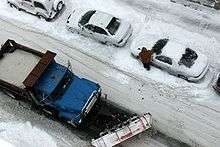Snow emergency

A snow emergency is the term used to indicate the active response plan when a snow storm severely impacts a city, county or town in the United States or Canada. Schools, universities, government offices, airports and public buildings may close during a snow emergency to prevent injuries during attempted travel; parking restrictions also usually go into effect to allow snowplows to clear the roads and streets effectively. The precise meaning of "snow emergency" varies depending on the issuing municipality. Snow emergencies are a common occurrence during the winter snowfall season in the Northern United States. The general public is alerted to snow emergency status via local broadcast stations, reverse 911 calls, mass text messaging services, public address systems, or lighted signals.[1]
Typically, a snow emergency is declared by the mayor or other chief executive official of a jurisdiction.[2] The declaration is usually issued after the winter storm has impacted a city or county. Winter Storm Warnings, Lake Effect Snow Warnings, Blizzard Warnings, and Winter Weather Advisories issued by the National Weather Service are taken into account when declaring a snow emergency.
During life-threatening winter storms, a state of emergency may be declared for an entire state. This allows additional measures to be taken by the executive, such as banning driving,[3] enforcing a curfew, and deploying personnel, equipment, shelters, or financial resources that would be otherwise unavailable.
Examples
Minneapolis defines a snow emergency as a predefined-duration period of specific parking rules to allow snowplows to move about the entire breadth of every city street.[4] On the other hand, Ohio snow emergencies are declared by the county sheriff's department on one of three levels; each level defines the recommended or mandated actions of the general public due to severe winter weather.[5]
Ohio Snow Emergency levels
Level One Snow Emergency: Roadways are hazardous and motorists should drive with extreme caution. During a Level One Snow Emergency, motorists may not park alongside streets or along roadways with signage prohibiting parking during a Snow Emergency. Vehicles may be fined or towed if they are not removed from designated Snow Emergency routes. A sustained snowfall of about 2-4 inches will likely cause a Level One Snow Emergency to be declared in some counties.
Level Two Snow Emergency: Driving is discouraged and residents should call ahead before heading to work. Only necessary travel is recommended during a Level Two Snow Emergency. Schools and some businesses do not operate during a Level Two Snow Emergency. A sustained snowfall of about 4-8 inches will likely cause a Level Two Snow Emergency to be declared in some counties.
Level Three Snow Emergency: All public roadways are closed to the general public. Only police, medical, and emergency vehicles should be on the roads. Motorists can be fined or arrested if found driving on public roadways in a non-emergency situation. If a Level Three Snow Emergency is declared when students are at school or when a public building is open, attempts are usually made by officials to provide food and drinkable water to those affected. A sustained snowfall of about 8-14 inches will likely cause a Level Three Snow Emergency to be declared in some counties.
See also
References
- ↑ Picture of signs with flashing blue light in Somerville, Massachusetts: http://blogs.wickedlocal.com/somerville/2008/12/19/snow-emergency-2/#axzz3QKV1xM6v
- ↑ http://www.cbc.ca/canada/story/1999/01/14/toronto990114.html
- ↑ http://wamc.org/post/ma-and-ct-declare-state-emergency-issues-travel-bans-winter-blast-nears
- ↑ http://www.ci.minneapolis.mn.us/snow/index.asp
- ↑ http://www.weathersafety.ohio.gov/SnowEmergencyClassifications.aspx